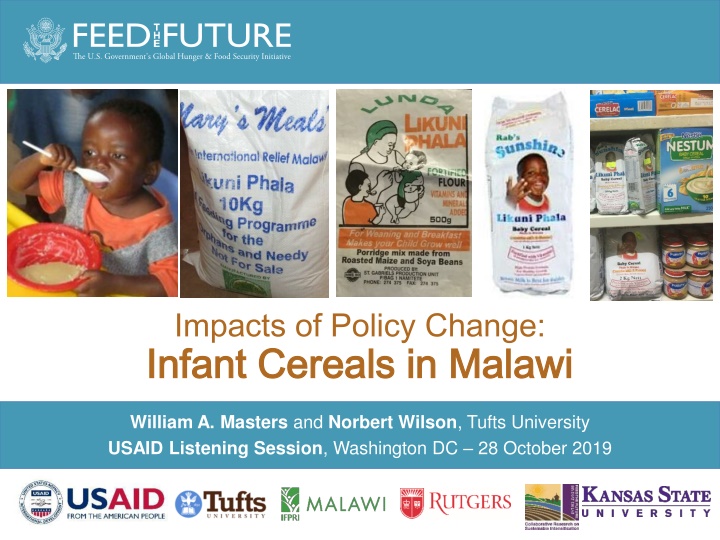
Impacts of Policy Change on Infant Cereals in Malawi
Explore the potential impact of policy change on infant cereals in Malawi, focusing on the need for standards and certification to drive market growth and ensure quality. Discover insights from market experiments and laboratory tests highlighting the demand for high-quality infant cereals among mothers.
Download Presentation

Please find below an Image/Link to download the presentation.
The content on the website is provided AS IS for your information and personal use only. It may not be sold, licensed, or shared on other websites without obtaining consent from the author. If you encounter any issues during the download, it is possible that the publisher has removed the file from their server.
You are allowed to download the files provided on this website for personal or commercial use, subject to the condition that they are used lawfully. All files are the property of their respective owners.
The content on the website is provided AS IS for your information and personal use only. It may not be sold, licensed, or shared on other websites without obtaining consent from the author.
E N D
Presentation Transcript
Impacts of Policy Change: Infant Cereals in Malawi Infant Cereals in Malawi William A. Masters and Norbert Wilson, Tufts University USAID Listening Session, Washington DC 28 October 2019 Photo Credit Goes Here
Why focus on infant cereals? Infants from 6 to 24 mo. have rapid potential growth but small stomachs, so need high density semi-solid foods Since the 1930s, premixed fortified cereals have been used successfully to complement breastmilk and facilitate transition to family foods Since the 1960s, modern food aid programs have used similar ready-to- cook premixes (now SuperCereal Plus) Every country has premixed cereals sold by local food companies -- but without standards or certification brands are not trusted, unless supported by expensive advertising
Malawis proposed national standard could drive private sector led growth The Malawi Bureau of Standards introduced infant cereal standards in 2017, but not yet implemented Standards and certification are needed for small, local entrants to compete with established multinationals To measure the potential impact of these standards, we did marketplace experiments with 359 mothers at 16 locations We also tested actual quality for 94 samples of 8 brands, to verify nutrient contents and mycotoxin contamination
, low actual quality We found high potential demand Little current use of premixed cereals (5% in 2015 DHS, 7% in our survey), but most (52%) mothers said premixed cereals were among their ideal infant foods In auctions, mothers were willing to pay <33% of Cerelac price for local brands, which is well above the estimated cost of production by small food companies In laboratory tests, actual products sold have wide range of actual contents Nutrient contents are unpredictable and often low Test results as percent of labeled values Mycotoxins often exceed national standards Test results relative to current and proposed standards +100% Aflatoxins (ppm) +50% 0 -50% -100% All test results are for n=94 samples from 8 brands Fumonisins (ppm)
Implications for nutrition policy Implementation of draft Malawi standard 90:2017 is needed now currently-sold foods are unpredictable and often dangerous many caregivers would buy premixed cereals if available and trustworthy Standards for infant cereals could be regional or global, to specify range of nutrient contents maximum contaminant levels labeling rules Certification to ensure compliance could use new field test kits as well as existing laboratory methods, plus inspections Standards would allow local millers and packagers to scale up production, distribution and use of proven food aid products like SuperCereal Plus to substitute for plain cereals among infants >6 months of age, and to complement continued breastfeeding and introduction of family foods Photo Credit Goes Here
Thank you! Our Feed the Future Policy Research Consortium work on infant cereals in Malawi builds on collaboration with Rachel Gilbert and the IFPRI Malawi country office, as well as Tufts students Jessica Wallingford, Binita Subedi and Ric Baily. We are especially grateful to our survey staff and respondents for our 359 marketplace interviews and 20 key informant interviews. Ethical review was conducted by the Tufts University Institutional Review Board for Social, Behavioral, and Educational Research (study 1833040) and the Malawi National Commission on Research in the Social Sciences and Humanities (approval number p.05/18/268). Photo credits: Rachel Gilbert in Malawi (2018), for interview training sessions with survey staff and infant cereals on shop shelves. Mary s Meals food and child eating at care center is from MamaLita (https://mamalita.org/2016/09/28/focus-on-likuni-phala); SuperCereal Plus being carried in Zimbabwe is from World Food Program; and Cerelac billboard by William Masters in Accra (2010). Photo Credit Goes Here
